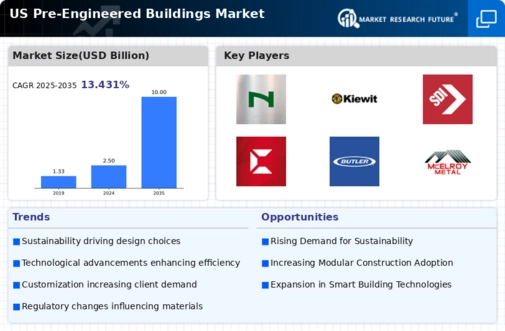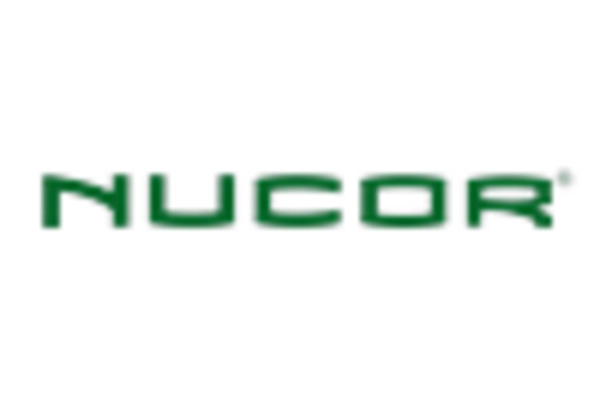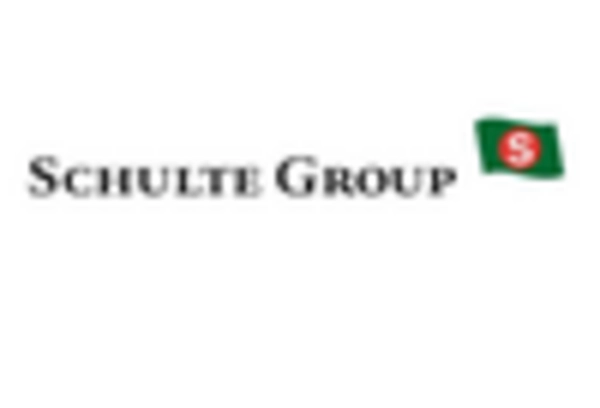Emerging Trends in Green Building Practices
The pre engineered-buildings market is witnessing a shift towards green building practices, driven by increasing environmental awareness among consumers and businesses. This trend is characterized by the integration of sustainable materials and energy-efficient designs in pre engineered structures. As more companies commit to reducing their carbon footprint, the demand for eco-friendly building solutions is expected to rise. Recent studies indicate that approximately 40% of new construction projects are now incorporating green building standards, which suggests a growing preference for sustainable practices. This shift not only enhances the market's appeal but also aligns with broader sustainability goals, potentially leading to increased market share for pre engineered buildings.
Rising Demand for Quick Construction Solutions
The pre engineered-buildings market is experiencing a notable surge in demand for rapid construction solutions. This trend is largely driven by the need for faster project completion times across various sectors, including commercial, industrial, and residential. In the current landscape, construction timelines are critical, with many projects requiring completion within tight schedules. Pre engineered buildings offer a streamlined approach, allowing for quicker assembly and reduced labor costs. According to recent data, the market is projected to grow at a CAGR of approximately 6.5% over the next five years, indicating a robust appetite for these efficient building solutions. As stakeholders increasingly prioritize speed without compromising quality, the pre engineered-buildings market is well-positioned to capitalize on this demand.
Increased Focus on Customization and Flexibility
Customization and flexibility are becoming paramount in the pre engineered-buildings market, as clients seek tailored solutions that meet specific needs. This shift is particularly evident in sectors such as retail and warehousing, where unique designs and configurations are essential for operational efficiency. The ability to modify designs and adapt to changing requirements enhances the appeal of pre engineered buildings. Recent surveys indicate that approximately 70% of clients prefer customizable options, which suggests a significant trend towards personalized construction solutions. This growing emphasis on adaptability is likely to drive innovation within the pre engineered-buildings market, as manufacturers strive to meet diverse client demands while maintaining cost-effectiveness.
Government Support for Infrastructure Development
Government initiatives aimed at bolstering infrastructure development are playing a crucial role in the pre engineered-buildings market. Federal and state programs are increasingly allocating funds for construction projects that utilize innovative building methods, including pre engineered solutions. This support is evident in various infrastructure bills that prioritize modern construction techniques to enhance efficiency and sustainability. For instance, recent legislation has earmarked over $100 billion for infrastructure improvements, which could significantly benefit the pre engineered-buildings market. As public sector investment continues to grow, it is likely to stimulate demand for pre engineered buildings, positioning them as a preferred choice for government-funded projects.
Technological Integration in Construction Processes
Technological advancements are reshaping the pre engineered-buildings market, as innovative tools and software enhance construction processes. The integration of Building Information Modeling (BIM) and advanced manufacturing techniques is streamlining design and production, resulting in improved accuracy and efficiency. These technologies facilitate better collaboration among stakeholders, reducing errors and delays during construction. Current estimates suggest that the adoption of such technologies could lead to a 20% reduction in project timelines, which is particularly appealing in a competitive market. As the industry continues to embrace technological integration, the pre engineered-buildings market is likely to benefit from enhanced operational efficiencies and improved project outcomes.

















Leave a Comment